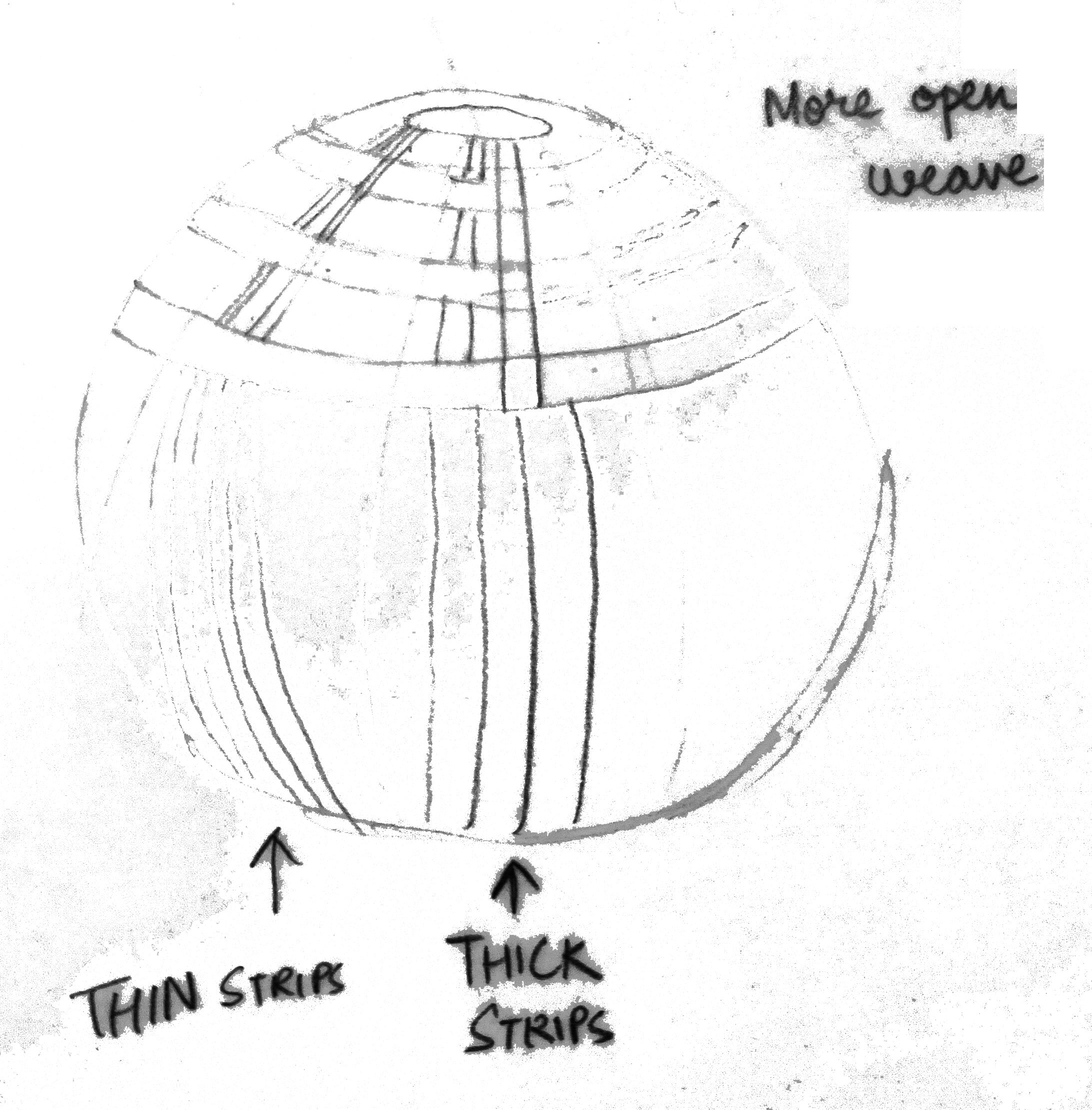- Social Innovation - Case Study - Craft Cluster -
RINGAAL BAMBOO BASKETRY
Ringaal Bamboo Basketry project is a cluster initiative focused on reviving the endangered heritage craft. It begins by conducting a comprehensive analysis of the current situation to identify key bottlenecks and challenges. By leveraging local knowledge, untapped skills, and resources, the project explores opportunities for intervention aimed at breathing new life into the craft.
Image: Nain Ram Ji, the last craftsman practicing the ringaal bamboo basketry in Munsiyari, Uttarakhand, India.
About this project
This craft project emerged from a collaboration between the National Institute of Fashion Technology, New Delhi and the Ministry of Textiles, India. The mission was to delve into one of India's fading heritage crafts and identify avenues for its revitalisation. Centred on the Ringaal Bamboo Basketry craft in the Himalayas, the project embarked on a journey to understand and uplift this traditional art form.
Conducting immersive field research aimed to meet with the local artisan and understand the intricate processes underlying the craft. Through these interactions, the key challenges and constraints faced by the artisan were identified.
Armed with insights gleaned from the field, the project pivoted towards employing design thinking for social innovation. This approach aimed to unearth innovative solutions to breathe new life into the craft, preserving its cultural significance while fostering sustainable livelihoods for artisans.
My Role:
Timeline:
Tools Used:
Industry:
Design Approach
Craft and Home Products
Field Research, Systems Map, Design Thinking
12 weeks
Researcher and Designer
Ringaal Bamboo Basketry
Introduction to the dying Indian handicraft
Bamboo mats and baskets are a significant part of the craft tradition of every agrarian culture. In Uttarakhand (India), the ringaal bamboo, found at high altitudes is used to weave mostu (floor coverings), chatais (mats), and baskets. These are sold locally. Products of ringal are particularly tough and durable. They are made with attractive lattice designs. Products include fruit and vegetable baskets, flower vases, vessels, and tea trays.
In 2005, there were more than 10 craft groups focusing on this craft in the district. However, with urbanisation taking over, the long, labour intensive hours of work are not appreciated by the newer generations.
Today, only 1 artisan is left to take forward this craft.
Field Visit: Munsiyari
Field research was conducted during a three-day visit to Munsiyari, Uttarakhand (India) where the last practicing artisan was visited to study the craft and gain insights into the challenges confronting the craft.
Image: Panchachuli, a captivating landmark in Munsiyari, consists of five snow-capped peaks, with the name translating to "five cooking hearths."
The Last Artisan: Nain Ram Ji
Nain Ram Ji is a 70 years old craftsman living in Munsiyari village in India's Himalayan region. He has been practising the eco-friendly craft of ringaal basketry since he started helping his father and grandfather at the age of 12. He learned the craft from them and continued the legacy. However, the legacy might come to an end after him, as his sons are not very supportive of the craft due to the minimal earning in return for heavy labour and long working hours.
Ringaal Basketry Process
Key Characteristics of Ringaal Basketry
Typically practised by farmers during the winter months.
Ringaal mats are commonly utilised in constructing mud-based flooring for houses.
Ringaal (dwarf bamboo) exhibits qualities of flexibility, durability, lightweight, and pliability.
Products range from utility to decorative items, including baskets (large and shallow), lamps, vases, boxes, mats (basket weave), winnows (close twill weave), and trays.
Weaves vary from plain, twill, basket, to hexagonal, featuring visible lattice designs.
Colours include dark/light green and black, achieved through burning old tyres.
Sustainability and eco-friendliness are inherent, with bamboo being naturally renewable and recyclable, promoting an eco-friendly alternative to plastic usage.
Systems
Mapping
This systems map, created after conducting a field visit and gathering insights from the artisan, offers an overview of the stakeholders and circumstances influencing the craft. It details how these factors interact and affect the craft’s sustainability and development.
Field-Work Research Insights: SWOT Analysis
Frustration Points
Reviving the craft of Ringaal basketry requires essential changes. Its decline is attributed to its labour-intensive nature and low income, dissuading future generations from pursuing it. Stagnant designs and limited product variety further exacerbate the decline. Additionally, the craft's reliance on individual artisan makes scaling up difficult without resources to invest in machinery.
To ensure profitability, three key considerations must be addressed:
Craftsmen should focus on urban populations with higher disposable incomes, who prefer value-added products.
Ringaal basketry requires radical innovation for modern homes while maintaining its handmade and sustainable qualities.
Attracting more manpower is essential as scaling up with machinery is not feasible.
Opportunity Identified:
Nain Ram Ji can train the women of the village, who could help in taking the craft further ahead.
In the village, societal norms and rules restrict women, limiting their independence. Although they assist as required, there are no designated roles for women beyond caring for the household.
— Women at Nain Ram Ji’s house
Scope of
Intervention
Within the scope of intervention and innovation, the situated knowledge of women in the village proves invaluable, particularly their adeptness in wool-working, crafting woollen sweaters for family members to endure the region's harsh winters. However, traditional gender roles confine these women to homemaking duties, limiting their engagement beyond the household. Yet, their lack of independent income sources presents an opportunity for empowerment, potentially bringing in new manpower to the craft. Moreover, teaching these women the intricacies of ringaal basketry and various yarn knotting techniques offers a chance to integrate wool into diverse products. Embracing mixed media can enhance product appeal and introduce new attractive colours, while upcycling materials like old clothes into strips offers sustainable alternatives to wool.
Plan of Action
To make the most of the village's skills, a strategy has been devised to combine Nain Ram Ji's eco-friendly ringaal bamboo basketry with the women's wool work, creating unique products appealing to urban consumers.
A ten-day workshop is planned to enhance market intelligence, introducing Nain Ram Ji and the women to urban market designs. With this insight, new designs will be developed and integrated into ringaal bamboo basketry.
The workshop will also focus on teaching various wool knotting techniques to Nain Ram Ji and the women, alongside sustainable basketry techniques. These skills can be easily shared and implemented without the need for additional tools or materials.
Despite limited technology access, training in selling and marketing skills will be provided to target tourists. Additionally, efforts will be made to connect rural craft with urban markets through government programs and collaborations with fashion houses, facilitating entry into trend-setting environments with eco-friendly products.
The intervention aims to preserve the dying handicraft and empower women economically, thus enhancing household income and living conditions. By leveraging local resources to create globally appealing products, the initiative seeks to add an innovative edge to revive the dying craft while fostering the formation of women's groups and promoting healthy relationships within the community. However, this plan of action has been put on hold due to the COVID-19 pandemic.
Theory of Change
(Projected Effects of Intervention)
Target Consumer Persona
To cater to the urban consumer, often found as tourists visiting the hill station, the following characteristics are outlined:
Geo-Demographics
Age group: Between 25-35 years of age
Income level: Middle to upper-middle class
Gender: Inclusive
Professions: Designer/artist, small studio owner or corporate employee who is into creative work on the side.
Location: Tier one/two cities
Socio-Psychographics
Hobbies/Interests: Loves doodling, painting and creating art. Interested in historic architecture, nature travel escapes.
Attitudes (taste) and preferences: Tends to associate with unique and artisanal products. Wants products to hold value and meaning.
Buying Behaviour: Likes to make purchases while travelling. Appreciates craftsmanship over machine made products. Believes in uplifting smaller businesses than purchasing from bigger brands.
Lifestyle of consumer (social associations): Like to spend time outdoors, nature-loving. Fond of near and dear ones.
Potential concerns and anxieties: Sometimes concerned whether the brand name is transparent and follows steps throughout the cycle and the end-of-lifecycle measures taken in order to assure the minimal impact on the environment.
Design Direction:
Proposing ideas for new products while incorporating yarn knotting techniques.
Form Inspiration :
Sea Urchin Shell
Drawing inspiration from the relationship between the snow-capped peaks of Munsiyari and tranquil waters, I aim to harness the calming energies of water to foster a sense of lightness during moments of stress.
Utilising the fundamental construction style of baskets, which is prevalent in Ringaal bamboo basketry, I seek to enhance its appeal through the integration of yarn knotting for added desirability.
Additionally, taking cues from the robust structure of sea urchins, I plan to replicate it through bamboo weaving while enhancing aesthetics with decorative yarn knotting elements.
Design Development:
Design Intervention + Form Inspiration = Product Prototype
Picnic Basket
Prototype
Proposed Sample
This virtual prototype offers a visual representation of how a simple intervention can innovate the craft. It showcases wool knotting alongside an open weave basketry construction, involving the contribution of village women. Ideally, these products would be developed in collaboration with the artisan. However, due to the challenges posed by COVID and the remote nature of Munsiyari, this collaboration was difficult to achieve. Hence, this virtual prototype serves to convey the potential appearance of the products.




3D Prototypes created in collaboration with a 3D artist.
Proposed Ideas for New Products:
Wool-Wrapped Vases: Combine ringaal bamboo vases with wool wrapping techniques for visually striking decorative pieces.
Mixed Media Lampshades: Enhance traditional ringaal lampshade designs with yarn and bamboo weaving for unique lighting fixtures.
Woven Wool Mats: Introduce wool weaving into ringaal mat production for soft, durable mats with added aesthetic appeal.
Textured Wall Hangings: Utilise ringaal bamboo frames adorned with intricate yarn knotting patterns to create statement wall decorations.
These product ideas aim to blend traditional ringaal basketry with contemporary creativity by incorporating yarn knotting techniques taught to the village women.
Feasibility and Limitations
The feasibility of this initiative prompts us to delve into several key considerations.
Firstly, we need to meticulously evaluate the durability and strength of the yarn knotting, exploring factors such as its resilience against wear and tear, as well as the time investment required for its production.
Secondly, it is imperative to confront and address the cultural stigmas that may hinder women's participation in this craft. This entails examining potential reluctance among women, assessing the extent of influence wielded by their husbands, devising effective communication strategies, and navigating any cultural or gendered connotations associated with this type of work.
Furthermore, practical aspects such as how women will procure the necessary raw materials for their involvement must also be carefully contemplated.
Image: Nain Ram ji with his family.

































